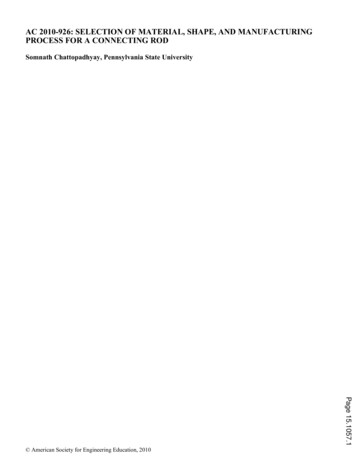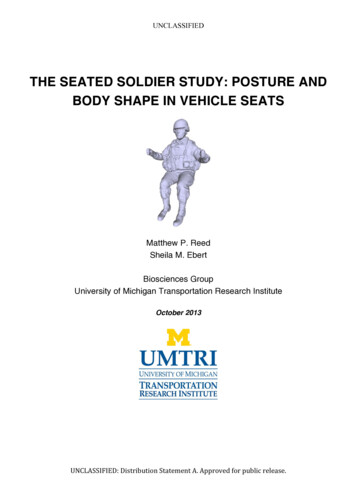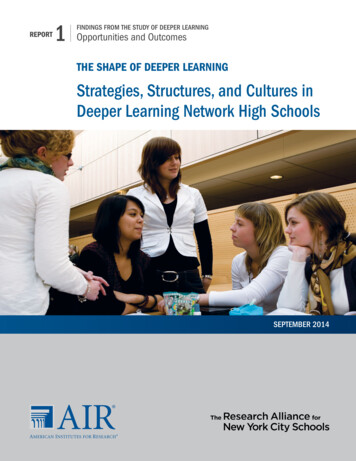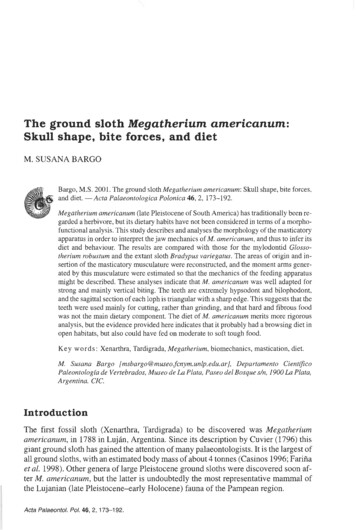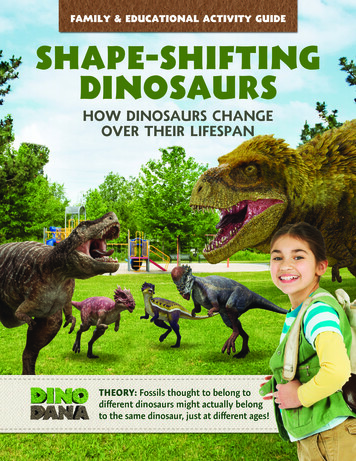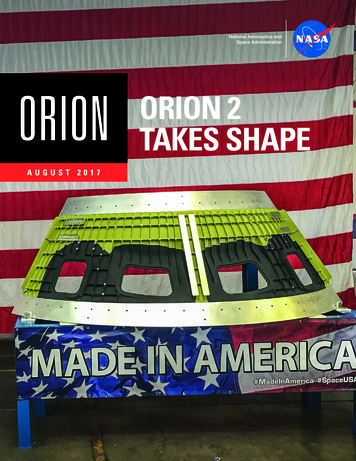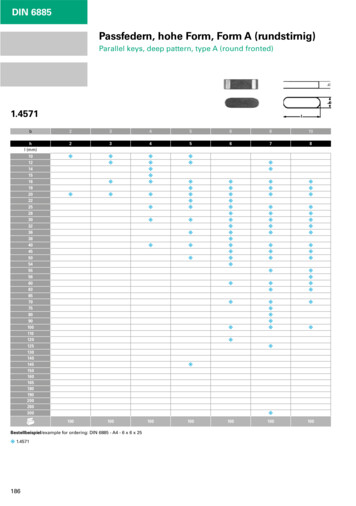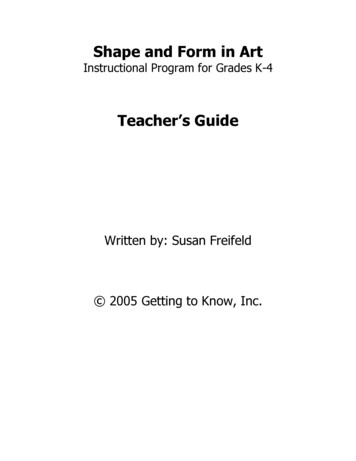
Transcription
Shape and Form in ArtInstructional Program for Grades K-4Teacher’s GuideWritten by: Susan Freifeld 2005 Getting to Know, Inc.
2Shape and Form in ArtInstructional Program for Grades K-4Teacher’s GuideContentsIntroduction and Student Objectives 3Chapter Topics from the Program .4Hands-on Activities*Kindergarten .51st Grade .62nd Grade .73rd and 4th Grade .8Reproducible Handout – Designs from Nature 9Shape and Form Glossary 10,11Books and Sites 12Conclusion and Review Questions .13National Content Standards for Visual Arts Education,Grades K-4 .14*Correlated to the National Content Standards for Visual ArtsEducation, Grades K-4
3Shape and Form in ArtInstructional Program for Grades K-4IntroductionThis delightful program covers basic information about shape and form in art forearly elementary students. Colorful animated sequences define shape and form.Other topics include: geometric and organic shapes, shape and form in the worldaround us, shape in painting, form in sculpture, shape and pattern, negative andpositive shapes, and shape as a tool for drawing. Additional titles in the seriesinclude Line in Art and Color in Art.Student Objectives(Correlated to the National Standards for Visual Arts Education) After viewing the program, students should be able to Understand that shape and form are an important part of the world around us,and important elements of art.(Content Standard 2) Identify and define geometric and organic/freeform/biomorphic shapes.(Content Standard 5) Understand the difference between shape and form and the difference between2D and 3D.(Content Standard 5) Notice various types of shapes in the natural world.(Content Standards 2, 6) Explain how shape and form are used in the compositions of paintings andsculptures.(Content Standard 3, 4, 5) Define symmetry (simple bilateral) and recognize it’s use in masks and other artworks.(Content Standard 3, 4, 5) Define and recognize negative and positive shapes.(Content Standard 3, 4, 5) Recognize and create patterns and motifs.(Content Standard 2, 6) Identify and utilize shape as a tool for drawing.(Content Standard 1)
4Shape and Form in ArtChapter Topics from the Program1.What is Shape? What is Form?2.Kinds of Shapes and Forms3.Shape and Form in the World Around Us4.Shape in Painting5.Form in Sculpture6.The Human Shape and Form in Painting andSculpture7.Shape and Pattern8.Negative and Positive Shapes9.Shape as a Tool for Drawing10. Conclusion and Review
5Shape and Form in ArtHands-on ActivitiesKindergartenYou may want to create a variety of prepared tubs for kindergarten art centers,many of which help teach about shape and form. These activities are very openended, with few instructions to follow, and therefore they make a good balancefor more complex art activities with many directions and steps. Kindergartenerswill naturally create patterns with all of the following activities, and correlationsto hands-on kindergarten math will be strong.Use of Shape TemplatesFind large plastic shape templates and stencils to put into a tub with coloredpencils and thin markers and plenty of paper. (Content Standards 1, 2, 6)Shape Stamping and SpongingOffer stamps and/or sponges in shape varieties, with stamp pads or trays withsmall puddles of washable tempera paint. (Content Standards 1, 2, 6)Shape Magnets and/or Felt BoardsLakeshore Learning (see the Books and Sites section of this guide for thewebsite) or other early childhood catalogues offer products such as magnetboards and/or felt boards, which can be assembled to create images. (ContentStandards 1, 2, 6)Foam or Wood Shapes with glue on boardCut a variety of poster board sizes, and offer these with foam and/or woodshapes for image creation. (Again, foam or wood shapes are in the schoolcatalogues.) (Content Standards 1, 2, 6)Sketching Animals from ShapesIf you demonstrate step-by-step drawing from shapes, kindergarteners are readyfor this, especially as the year progresses. Books by Ed Emberley, and othersimple drawing books (topics could include animals or vehicles, or cartooncharacters such as Pokemon, or any other high-interest subject many areavailable) can be used. Put these in a tub with a variety of drawing materials.(Content Standards 1, 2, 3)Building Blocks, Straws, etc.Building blocks, straws or other 3D play object are great for teaching aboutshape and form. (Content Standards 1, 2, 6)Free work with Play-dohStudents love creating shapes and forms with play-doh. Collect cutters, rollersand other appropriate tools. (Content Standards 1, 2)
6Shape and Form in Artst1 GradeCartooningHands-on ActivitiesFirst graders enjoy simple step-by-step cartooning. Demonstrate animals, orhuman faces with different expressions, using shapes of all kinds. Encouragestudents to make their own characters, not just copy from known or commercialcharacters. Students can ask each other to look at their cartoons and see if theycan “read” them detail and color will be important in the creation of anidentifiable human or animal character. (Content Standards 1, 2, 3, 5)MandalasMandalas are radially symmetrical designs (symmetrical around a center) thathave universal appeal. They can be found in many cultures and time periods. Awheel and a flower are both mandalas, as are a Tibetan sand painting and thestained glass rose window of a cathedral. Give students square paper of anysize and show them how to fold the paper, first in half in one direction, and thenin half the other way, to find the center. They can put a big dot in the center ofthe paper. Then, show them how to add shapes in each of the four quadrants,turning the paper as they go. (The paper will actually spin if the folds are doneone at a time, opening the paper after the first fold.) Each shape they addshould be the same shape and color, something easily repeatable. Demonstratefor them that the more shapes and colors added, the more fancy and beautifulthe mandala will become. (Content Standards 1, 2, 3, 4)Simple OrigamiFirst graders can learn that origami, or the art of paper folding, is a Japanesecraft that is popular with all ages. Any fairly thin, precisely square paper can beused for origami. Origami also has value as a math activity. There are manygreat origami resources out there, but many origami creations are too difficultfor the average 1st grader. Easy ones to start with are the cat or puppy and kite.These can be glued to paper, and embellished with hand-drawn details to createa “Spring Picture”. The kite is made from one paper, the cat/puppy body is onepaper, and the puppy head is a third paper. Instructions for these simpleorigami pieces should be available in many resources.(Content Standards 1, 2, 3, 4, 5, 6)
7Shape and Form in Art2ndHands-on ActivitiesGradeScribble DesignsThis perennial art teacher and student favorite is a good project for awareness ofshape variety. On a small piece of paper (6” x 9”), students draw an all-overscribble design, trying to make shapes of different sizes as they draw. Then,using any media, students color in all of the shapes to produce a finishedabstract composition. (Content Standards 1, 2)Geometric Coloring SheetsA variety of coloring books are available with have geometric designs andpatterns (see Books and Sites section of this guide.) These are great to offerin wide variety, stressing careful craftsmanship when coloring.(Content Standards 1, 2, 6)Cut-paper CollagesCut or torn paper collages help give students a tactile/kinesthetic relationship toshape and form. Subject matter can range from a self-portrait to a still life, oran interpretation of a masterwork by a great artist such as Henri Matisse.(Content Standards 1, 2)3-D Paper MasksMask-making projects can help teach concepts such as symmetry, exaggerationand expression, color relationships, and multi-cultural awareness. One greatresource for 3D masks is Peggy Flores’ video, Maskmaking with Paper,produced by Crystal Video. There are other mask project designs, and verysimple ones will work. Providing examples to look at and a demonstration willhelp students get their best ideas going. Students can discuss visual aspects ofthe finished masks. Each student can chose a favorite (not their own) and tellwhy they like it. (Content Standards 1, 2, 3, 4, 5, 6)Clay ProjectsStudents can create a clay slab and cut shapes from the slab, using cookie andclay cutters. Poke a hole in the top of each shape. After firing and glazing,these shapes can be strung together with wire and string to create a mobile orwind chimes.Other good clay projects include coil pots or small animal sculptures.(Content Standards 1, 2
8Shape and Form in ArtrdthHands-on Activities3 and 4 GradeMobiles with Organic ShapesStudents can study the organic forms in the mobiles of Alexander Calder, theartist who invented mobiles. Using scissors, hole punches, colored tag boards,string and easily bendable wires, students can construct mobiles. Themes maycenter around the ideas of abstract organic shapes, or more naturalistic ideaslike undersea life, outer space, or the circus.(Content Standards 1, 2, 3, 4, 5, 6)More OrigamiIn third and fourth grade, students will really begin to love origami. Teachorigami projects which are not too difficult and demonstrate each one severaltimes. Origami that works well at this level includes: drinking cup, square box,rectangular box, helmet, house, whale, sailboat, and the water bomb. These areclassical origami items, instructions for which can be found in many places.(Content Standards 1, 2, 3, 4, 5, 6)Foil or Papier-Mache MasksTooling foil, placed on a cushion of newspaper, can be easily drawn on, and thenpressed with clay tools into a 3D mask form. Students can draw symmetricalmask designs first on paper, looking at masks from around the world forinspiration. Finished foil forms can be cut with scissors and colored withpermanent markers.Papier-mache can be formed over a commercial plastic mask form, or over clay,which students have modeled. Use several layers of newspaper strips dipped inart paste, and allow the paste to dry between layers. Paint with tempera paintand finish with a clear spray finish. Embellishments can include sequins,feathers, raffia, 3D paper elements, yarn, etc.(Content Standards 1, 2, 3, 4, 5, 6)Modeling/Shading of FormsTeach students how to model simple shapes to produce an illusion of 3D form.As in the video, start with a circle, and indicate the light source (sun). Thenshow how shading the side of the circle away from the sun gives a 3D illusion.Students can expand their abilities with this idea by drawing planets on blackpaper with oil pastels. Using plenty of white oil pastel will help with the dramaticeffect of blending the dark to light side of the planets.(Content Standards 1, 2)ClayClay projects mentioned Projects for Grade Two would also work well for 3rd and4th graders. (Content Standards 1, 2)
9NameDESIGNS FROM NATUREClassBe inspired by the natural world. On the left are some shapes and forms fromthe natural world. In the empty boxes on the right sketch a design of somepractical object like shoes, a chair, a car, a house, teapot, or anything useful.Let your design be based on the forms of the natural objects.Share your ideas with the class when you are finished.Shape and Form in Art
10GlossaryBalance – principle of design in which elements of a compositionseem well arrangedComposition – the ways in which the elements of a work of art arearrangedDetail – the small, well-defined parts of a work of artExpression – emotion or feelingsForm – element of art that refers to the three dimensional – havinglength, width and depthGeometric Shapes – the shapes known by names: circle, square,triangle, etc.Gestural Drawing – drawings done quickly to capture movementHighlight – the small, bright white areas on objects that showreflected lightInspiration – the ideas, motivation, and enthusiasm to produceartworkMotif – a repeated group of elements from a patternNegative Shapes – background or non-subject area shapes in a workof artOrganic Shape (also known as Free form or Biomorphic Shapes) –the shapes without names, frequently from nature
11Shape and Form in ArtGlossary (continued)Pattern – repeated shapesPositive Shapes – subject area shapes in a work of artRelief Sculpture – a sculpture that comes forward from a flat surface,as opposed to being freestandingScale – relative sizeSculpture – three-dimensional artworkShape – the element of art that is a distinct space, having length andwidth, (2 dimensions); a shape is created when a line reconnectswith itselfSymmetry – identical balance on two sides of a center line (bilateral);or balance around a center point (radial)Three-dimensional (3D) – having length, width and depthTwo-dimensional (2D) – having length and width but no depth (flat)
12Shape and Form in ArtBooks and SitesFind a wide variety of useful picture book resources on multicultural topics, origami, masks,geometric and other unusual coloring books, at:http://store.doverpublications.com/Excellent videos for the classroom on many art topics including masks and elements of x.phpThe PBS series “Reading Rainbow” covered many wonderfully interesting topics, many of whichwould extend a study of shape and form in art. Videos or DVDs and teacher guides are availableto order at:http://gpn.unl.edu/rainbow/The Getty Museum has many resources for teachers at:http://www.getty.edu/education/search/Getting to Know the World’s Greatest Artists Series, books by Mike Venezia and videosbased on the books. These are excellent books and videos for teaching about art history, withclear information and entertaining humor. The websites are:http://www.gettingtoknow.comhtt
More Origami In third and fourth grade, students will really begin to love origami. Teach origami projects which are not too difficult and demonstrate each one several times. Origami that works well at this level includes: drinking cup, square box, rectangular box, helmet, house, whale, sailboat, and the water bomb. These are
